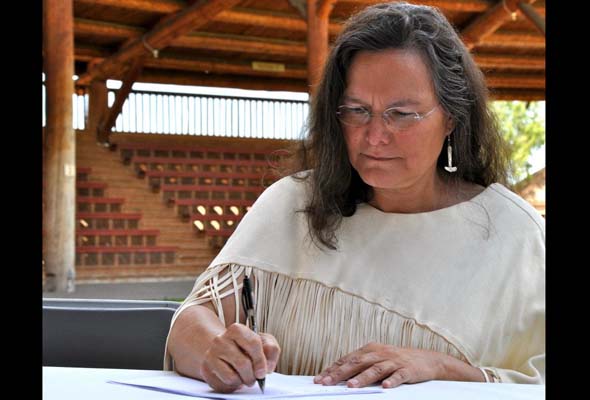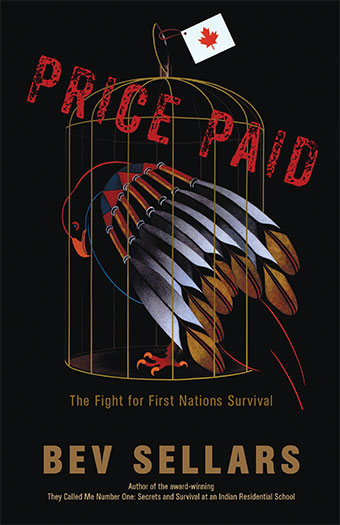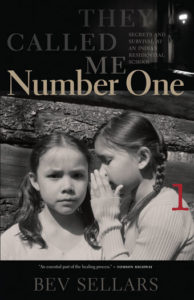
Interview by Heather Ramsay
Bev Sellars has had many roles in her community. She was elected chief in 1987-1993 and again from 2009-2015. She stepped forward and was featured in newspaper and television accounts when her community of Xat’sull (Soda Creek) first spoke out against residential school abuses in the early 1990s. She also earned a degree in history from the University of Victoria and a law degree from the University of British Columbia, and served as adviser for the BC Treaty Commission.
Now an author, her first book, They Called Me Number One: Secrets and Survival at an Indian Residential School (Talonbooks, 2013), won the 2014 George Ryga Award for Social Awareness in Literature, took third prize in the 2014 Burt Award for First Nations, Métis and Inuit Literature and spent more than forty weeks on the BC bestseller list.
PRISM’s editorial board member Heather Ramsay sat down with Sellars to discuss her latest eye-opening work, Price Paid: The Fight For First Nations Survival (Talonbooks, 2016).
Your first book, They Called Me Number One was such a powerfully personal book. I understand that writing it was a path to healing for you. Now you’ve written Price Paid: The Fight for First Nations Survival. While this book is very much written in your voice and includes injustices you’ve experienced in your personal life and your twelve years as chief of the Xat’sull (Soda Creek) First Nation, it focuses more on the larger picture. How did this book come into being? What was the impetus for writing it?
 When I first went to work for the BC Treaty Commission, I was assigned to 11 different negotiating tables. A lot of the people I worked with had no idea why they were negotiating. They were just arguing the BC stance or the Federal stance. Even some of the Native people didn’t know the history. I asked my supervisor if I could put together a history document. He said I could, but I’d have to do it off the side of my desk. Later, when Steven Point became treaty commissioner he said, yes, put it together and go out and deliver it. I’ve delivered it for school districts, government offices and First Nations all over the province. I’ve delivered it at least 100 times to a whole range of people—except the federal treaty negotiators. The ones I developed it for in the first place.
When I first went to work for the BC Treaty Commission, I was assigned to 11 different negotiating tables. A lot of the people I worked with had no idea why they were negotiating. They were just arguing the BC stance or the Federal stance. Even some of the Native people didn’t know the history. I asked my supervisor if I could put together a history document. He said I could, but I’d have to do it off the side of my desk. Later, when Steven Point became treaty commissioner he said, yes, put it together and go out and deliver it. I’ve delivered it for school districts, government offices and First Nations all over the province. I’ve delivered it at least 100 times to a whole range of people—except the federal treaty negotiators. The ones I developed it for in the first place.
Former BC Premier Mike Harcourt was a Treaty Commissioner and invited me to present at a planning conference he was hosting. He saw the presentation and wanted me to turn it into a book. He offered to introduce me to his publisher, but I never followed up with him. When my publisher, Talonbooks, was looking for a second book, I thought of his remark.
You start your book by showing the difference between newcomer history and the perspective of Aboriginal people. Your daughter, Jacinda Mack’s example of re-captioning historic photos—those that gave full names and titles for European men, but referred to the Indigenous people in the image generically as “Bella Coola Indians” is a striking example of the dismissal of Indigenous lives. Jacinda showed that it wasn’t difficult to find the identities of these people. She found the names of the Nuxalk in the photographs by asking living community members and then changed the caption and used generic terms, like White Man, for the visitors. Her fellow anthropology students and teacher were upset at this turnaround. Can you talk a little more about this?
One of the really important reasons that I wrote my first and second books is because there is tunnel vision in Canadian history. There are all of these things that happened, but no one mentions them. The fact that millions and millions of Indigenous people died from diseases [brought by Europeans] is not mentioned anywhere. Well, maybe it is now. People are starting to talk about it. But when I was growing up, I knew people in my area died of small pox and I knew there were villages where people were completely wiped out, but there was not even an indication of that in the history books.
In the history books, there might be something that dismisses my people [referring to the pictures that do not name people] even though they might have been in an important position. So what [Jacinda] did was to turn that around, to help other people to realize how we see it, from our point of view.
For example, just north of my community there was a huge Secwepemc village that was wiped out by small pox. But they were all buried in mass graves around there. And when they put the highway through, no one ever came to us. I know they must have unearthed some of the remains. But the highway just went right through. I think of that all the time and it really bothers me.
You’ve written that you never wanted to study history. That history books, as far as you were concerned ignored Indigenous history. When did you realize how important it was to learn about our shared past? Do you remember a particular “aha” moment?
My “aha” moment came when I was taking European history. They were talking about the plague and the social chaos—the fallout from it. How the people used alcohol heavily and there were children running around not being taken care of. I thought that’s no different than what we’re being criticized for. And we’ve had how many hundreds of years of being traumatized? But we’re still here and we’re still fighting.
Yes, we have social conditions. But the reason we have social conditions is not because we are Indigenous; it is because we are human. I keep telling people that if you take any group of people and put them through the same thing, they’ll have the same social conditions.
That really struck me when I was studying European history. You see in the newspapers that Indians can’t handle alcohol. Or that that we live on welfare and pay no taxes. That we are drunk, dirty and lazy. I knew that wasn’t true, but until I went to university, I didn’t have the tools to correct the myths that were being put out there.
I’d been raised to believe that white people were perfect. All of the early shows on TV… I had nothing to compare that to. I didn’t know any white people. I’d never been in a white person’s home. So I assumed that everything I saw on TV was true. In movies, the Indians were always bad people. Everything that society was telling me about myself was bad. So it took me a long time to get over that.
“What if you owned a house and a beautiful garden? Would you share it with others? Would you welcome them? . . .What if the newcomers began to fill the house and outnumber your family? Does that make the house theirs?” You use the metaphor of a house to introduce the chapters in your book and the layers of colonial history. Why did you decide to do this?
Everyone can relate to having a house. Even homeless people have a space they call home. And when they invite people in, they expect their guests to be respectful of their home. I used the metaphor in [the chapter headings] so people can relate. Originally, I had the metaphor in the back of the book, in one chapter only. It was one of the editors at Talon who suggested I take the metaphor and split it up by putting it in each of the chapters.
I like it because it explains how Indigenous people feel. This is our home. Everyone else [in Canada] has a homeland they come from. But everything we have is here.
That reminds me of a phrase in your book. You write: “There are only two truths, death and taxes,” but you also note a third truth:“That Aboriginal people will always be in their homelands.”
Yes. A number of years ago someone said [to me], why don’t [people] just move? They are out on remote lands and they are costing people money. I just couldn’t believe their ignorance of the Indigenous people and their connection to the land. We’re also out there protecting the land. If it weren’t for us being in those remote places, people would come in and the environment would be totally destroyed by now. The Indigenous people still are trying to protect their homelands
 What do you think the barriers are? The ones that stop all Canadians from learning and really understanding the truth of our shared history?
What do you think the barriers are? The ones that stop all Canadians from learning and really understanding the truth of our shared history?
I think they don’t know it. Even recent immigrants come and they are taught a history that isn’t complete. They have nothing else to look at, so they believe it too. But I think it’s changing and the reason I think that is: When I first started speaking out about residential schools, it was my first term as chief. I was reluctantly pushed forward as the spokesperson for our tribal council. All of a sudden I was on the front page of every newspaper in Canada and the Fifth Estate [in 1992] came and did a story on it.
I started getting hate mail and the letters were just awful. “How dare you Indians accuse the Catholic Church for atrocities.” They said that could never happen. Those schools were good and you should be thankful you got an education. Anyway I burnt those letters and now I really wish I still had them. But at the time they were just so ugly that I threw them into the fire.
When my first book was coming out, I warned my kids, ‘We’re going to get hate mail.’ My grandkids are on the cover, so I said, please make sure they don’t see or hear anything. But when the book came out, all of the emails, all of the letters and phone calls—I have not received one negative comment.
Then, in Vancouver we had the Truth and Reconciliation Commission walk in 2013. I was amazed at how many non-Indigenous people were there. Seventy thousand people came out in the pouring rain to support the former students of the residential schools. I think it’s starting to change. People are seeing that the history they were taught is not right and books like mine, and a lot of other good ones, are going into the curriculum now.
Do you believe that if people know the truth, this will make things better for people in First Nations communities?
So many people have apologized to me for what happened. And I keep telling them. You are not personally responsible for the policies and everything. But now that you know, you can’t turn a blind eye. There are still things that are affecting us today. Everywhere I go I tell that to people.
What is the most important thing that has to happen to change the relationship between Canada and the First Peoples of this country?
I think that they need to listen to what Indigenous people need to make their communities whole again. Because it’s not what the government wants to give us or what others are willing to give up. People need to listen to what we need. And not just a little bit of money here and there. Money doesn’t help anything. It’s got to be a whole range of things. Aboriginal people need to be in charge of their lives. So many things are still dictated to us. All of the funding we get comes with so many strings attached and we’re not allowed to make our own decisions.
We apply for these programs because that is the only avenue we have. But we don’t get to define what is needed in our community. All of a sudden we get a letter, that this pot of money is available. Then these are the guidelines or the strings attached.
When I was first chief [in 1987], we got $300 a year for economic development. I asked the band, what it’s up to now and it’s like $1500 for our entire band—for everybody—for a year. I don’t know what the hell we can do with that, but anyway. Then there’s the welfare budget. It doesn’t matter what we ask for, we get it. Several years ago, all of the chiefs got together and wanted to switch the welfare money, to economic development [so they could create jobs for people] but that wasn’t allowed.
There are stories like that right across the country. The fishing industry. On the prairies when Indigenous people started doing really well all of a sudden there were all these restrictions put up. The whole thing was to stop Indigenous people from being successful so the newcomers could be the ones that were successful.
On that note: What do you think of the coming celebrations for Canada’s 150th birthday?
In Chief Dan George’s [Geswanouth Slahoot of the Tsleil-Waututh Nation] words, spoken at a 100th anniversary celebration—these words also inspired the title of Price Paid:
“We are a people with special rights guaranteed us by promises and treaties. We do not beg for these rights, nor do we thank you. . . we do not thank you for them because we paid for them. . . and God help us, the price we paid was exorbitant. We paid for them with our culture, our dignity and self respect. We paid and paid and paid…”
Indigenous people are not going to be celebrating. Now it’s 50 years later and his words still resonate. I’m doing my darndest to teach people about the real history. I just hope that that is the year we can finally turn and make it a country for all of us. It’s been too long. We’ve been beggars in our own home too long.
Heather Ramsay is an MFA candidate in UBC’s Department of Creative Writing. Her work has appeared in The Tyee, Maisonneuve, Vancouver Review, Room, The Globe and Mail and Canada’s History Magazine. She is on the PRISM Editorial Board.